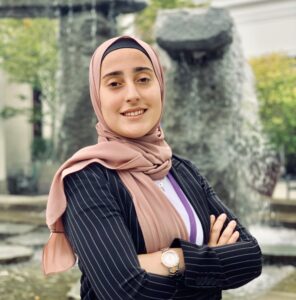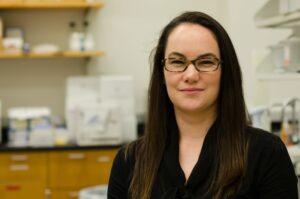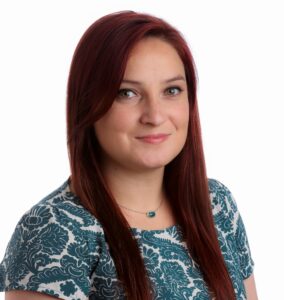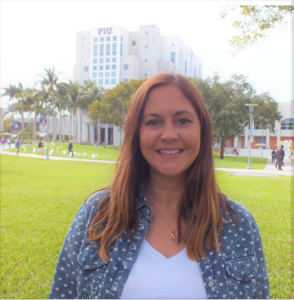This year marks the 30th anniversary of the International Symposium on Human Identification. Much has changed since the first gathering in 1989 when the field was in its infancy. Throughout this anniversary year, we’ll be celebrating the men and women who perform the demanding but crucial work of the forensic scientist, as well as exploring how the field of forensic DNA has changed over the decades.
We know that it takes a special kind of person to choose forensic science as a career, and this year, we’d like to recognize a few of the students who are making a difference in the field. We’re excited to introduce our first ISHI Ambassadors! These students are all pursuing advanced degrees in the field of forensics. They will be participating in this year’s 30th International Symposium on Human Identification in Palm Springs. Follow Mirna, Rachel, Allison, and Fabiana on social media as they share highlights from the ISHI workshops, presentations, and poster sessions. We’ll also hear about the fun moments in between the scientific sessions including the Welcome Reception, Trivia Night and Street Party dinner. We look forward to seeing the meeting through their eyes, and learning more about their research and career aspirations.
Mirna Ghemrawi – Ph.D. Student, Biochemistry Program/Forensic Track, Florida International University
 Ever since I was young, because I had lighter skin than my siblings, they always teased that I am not part of the family and that I mistakenly been switched in the hospital. Thus, I always wanted to dig into my family’s DNA to prove them wrong, not knowing that it was all a joke. I was also very intrigued by Crime Scene Investigation shows and decided since then, that I wanted to be a forensic scientist. Despite those shows being mostly fictional, they have some elements of reality.
Ever since I was young, because I had lighter skin than my siblings, they always teased that I am not part of the family and that I mistakenly been switched in the hospital. Thus, I always wanted to dig into my family’s DNA to prove them wrong, not knowing that it was all a joke. I was also very intrigued by Crime Scene Investigation shows and decided since then, that I wanted to be a forensic scientist. Despite those shows being mostly fictional, they have some elements of reality.
Growing up in Lebanon, forensics was not well established as a major. However, after concluding my undergraduate studies in Medical Laboratory Sciences, I was granted the Fulbright Scholarship to pursue my master’s studies in Forensic Science in the United States. I was lucky to have hands-on experience from sample collection to data analysis in Forensic DNA phenotyping, predicting eye, hair and skin color of a Lebanese admixed population.
The more I learn about DNA and its power in solving crime cases, the more I want to study and research about it. My passion towards forensics led me to start my doctoral studies at FIU where I am mainly interested in microbiome and species identification for forensic application.
After graduation, I plan to contribute back to my home country, Lebanon, and share my experience back there. I would like to be part of the government crime lab, where I can implement the up-to-date techniques and standards in our routine tests. I also see myself in academia where I would have an opportunity to start an interdisciplinary major in forensic science, giving students the chance to study forensics without the need to travel abroad. Since not every student is lucky enough to travel, I think it’s their right to find the major they like in the place they live in.
Follow mirna on INSTAGRAM or TWITTER or connect with her on LINKEDIN.
Rachel Kieser – Ph.D. Student, Biomedical Sciences, Center for Human Identification, UNTHSC
Pursuing a career in forensic science, either from a research or casework perspective, is often a rigorous undertaking. While it is a career that calls for incredible attention to detail and expertise, it also relies heavily on one’s dedication and fortitude to continuously examine the evidence. Throughout my graduate training, I have come to realize that research may not always be easy or straightforward; but through determination and persistence, it can provide answers to questions of human identification. Advances in scientific research not only impact historical accounts, but also provide investigative leads to assist in solving crimes.
I have always possessed great interest in the fields of molecular biology and genetics. As a child, I would become immersed in murder mysteries, constantly trying to solve the “who-done-its” and bring the criminals to justice. As forensic genetics emerged as its own discipline, I found myself enamored with its seamless integration of my passions. As it is often times a challenging career, it is by far one of the most rewarding. My goal is to pursue a career in academia, educating the next generation of forensic scientists while continuing research in hopes to considerably contribute to the field’s advancement.
My research centers on the development of novel methods to achieve efficient targeting and enrichment of highly degraded and damaged DNA. These samples are often skeletal remains that have been exposed to time and damaging environmental conditions that leave the remaining nuclear DNA nearly impossible to target with current methodologies. Although this work is tedious and a single variable can have a significant impact, it is the motivation that continuously pushes me to strive to achieve something that has not been done before. I have had the immense privilege to study under Dr. Bruce Budowle and have had the opportunity to take part in the research that pushes the limits of our current technology.
At this year’s ISHI in Palm Springs, California, I will be presenting a novel methodology for genotyping highly degraded (fragmented) DNA. I describe in detail every aspect of the system’s validation as well as its use for genotyping the putative skeletal remains of the Medieval Spanish Royal House of Aragon dating in age approximately 850-950 years old. This innovative technology, Reverse Complement PCR (RC-PCR), employs a unique probe targeting system allowing for enrichment of highly fragmented DNA on template fragments only 50 bases in length containing identity informative single nucleotide polymorphisms (SNPs).
Follow Rachel on INSTAGRAM or TWITTER Or connect with her on LINKEDIN.
Allison Sherier – Ph.D. Student, Biomedical Sciences, Center for Human Identification, UNTHSC
 As an undergraduate, I studied beef cattle breeding and genetics. The projects I was a part of focused on the role genetics plays in producing quality beef for human consumption. These projects were the reason I fell in love with genetics. I began to realize family farmers and ranchers would appreciate immediate benefits from the advances new genetic research was making, but for practical reasons (e.g., monetary, lack of facilities, etc.), family farms are slow to adopt these breakthroughs for improving and managing their herds. Opting instead for incremental change relying on what had worked for generations. With this realization, I then knew I wanted to continue my education and involvement in research, but I wanted to work in a field that would have a direct and immediate impact on people’s lives.
As an undergraduate, I studied beef cattle breeding and genetics. The projects I was a part of focused on the role genetics plays in producing quality beef for human consumption. These projects were the reason I fell in love with genetics. I began to realize family farmers and ranchers would appreciate immediate benefits from the advances new genetic research was making, but for practical reasons (e.g., monetary, lack of facilities, etc.), family farms are slow to adopt these breakthroughs for improving and managing their herds. Opting instead for incremental change relying on what had worked for generations. With this realization, I then knew I wanted to continue my education and involvement in research, but I wanted to work in a field that would have a direct and immediate impact on people’s lives.
While researching different graduate schools, one of the programs I discovered was the Master of Science in Forensic Science at Oklahoma State University (OSU). Upon further investigation, I found that forensic genetic research was making an immediate difference in society. I could envision how the research I would conduct as a graduate student would almost immediately enhance and improve the results of processing DNA evidence in crime laboratories and help solve real-world problems. Seeing this impact, I decided I wanted to further my education and knowledge and obtain a Ph.D.
Obtaining my Ph.D. at the Center of Human Identification at the University of North Texas Health Science Center has exposed me to a wide range of forensic genetic issues and research that may solve some of these challenges. Last year at ISHI, I presented a validation study on Copan’s microFLOQ® Direct Swab as a potential sub-sampling technique for evidence, specifically sexual assault kits. It was also the first time I attended ISHI. Attending this conference provided me, as a student, a supportive learning environment and the unique opportunity to network with the best forensic geneticists in the field. I left the 2018 ISHI conference invigorated and excited to continue my research knowing the potential impact my work could have on the field of forensic genetics.
At ISHI 2019, I will present a portion of my Ph.D. thesis work which focuses on using the human skin microbiome as an alternative or supportive genome for human identification. Specifically, my presentation will focus on the approach of using Wright’s Fixation Index (Fst) and machine learning to select informative single nucleotide polymorphisms for an enhanced massively parallel sequencing panel. I am excited about the opportunity to share my work on the human skin microbiome for two reasons. First, the human skin microbiome may improve the chances of accurate identification of an individual who touched an item collected from a crime scene, when low levels of DNA are recovered. In addition, presenting my work will give me the opportunity to converse with fellow forensic scientists about a field that may not be very familiar with but is very exciting.
Follow Allison on INSTAGRAM or TWITTER or connect with her on LINKEDIN.
Fabiana Taglia – Ph.D. Student, Forensic Chemistry, Florida International University
My interest originated when I was fifteen years old during the class of Biology in high school in Rome, Italy. There was a great teacher, able to raise curiosity in everyone. I was so enthusiastic and always full of questions to ask him. I started to read Italian science magazines, and inside one of these I found an article on forensic sciences. It dealt with fingerprints, and I was so interested that I spent one week trying to catch my fingerprints on a table with tape and putting talc on it to detect them.
At the end of high school, I decided to enroll for the Bachelor of Science, and I continued my studies with a master of Genetics and Molecular biology. During my schooling, I worked on my thesis degree at the Italian National Health Institute, working in bioinformatics for the epidemiology unit. The research studies done were published in four different papers.
After this experience, I started to look for a master in forensic sciences, and I was very interested in working with Dr.Bruce McCord at Florida international University. Therefore, I applied for the master but I had to withdraw, so I then applied for MSFS in Italy.
I know very well what it feels to do the job you love but without recognition. In fact, I worked for more than four years in a forensic genetic laboratory in the university of Rome “Tor Vergata” in Italy without being paid, which is unfortunately very common for biologists in university laboratories.
I never gave up on the idea to come back to Miami to work with Dr. McCord, and this happened in 2015 when I came to Miami as an exchange visitor scholar. I worked in Forensic DNA research, which had always been my goal. I started to work performing a validation for a STR kit, and then my research project was focused on the sequencing of Y chromosome for identification purposes using the MinION from Oxford Nanopore Technologies.
After graduation, I see myself continuing the research in the field of forensic DNA. When I was younger, I thought my aspiration would be to become a forensic DNA expert for casework in law enforcement, but thanks to my experience as a PhD student, I realized how much I love the research and teaching. Therefore, I would like to pursue the academic career, having the chance to work with DNA, improving my knowledge and teaching students the love for forensics and helping them develop.
The poster I will be presenting at ISHI 30 is related to my actual PhD project. The purpose of my research study is to develop a method to sequence long-reads of YSTRs and YSNPs together, and demonstrate that this kind of analysis can be a very powerful tool in forensic genetic analysis. This project represents one of the first studies to analyze these polymorphisms using the MinION sequencing device from Oxford Nanopore Technologies.
The advantages are many; it could increase the power of discrimination between individuals and resolve complex mixtures, and should also help solve crimes when male perpetrators belong to the same family. Moreover, in presence of mixtures of more than one male, it will be possible to infer the number of contributors and determine their relative contributions. Finally, the use of linked YSTR and YSNPs may provide additional insight into possible geographical localization of the suspect in those forensic cases in which there is no suspect and no witness.
Follow Fabiana on INSTAGRAM or TWITTER or connect with her on LINKEDIN.
WOULD YOU LIKE TO SEE MORE ARTICLES LIKE THIS? SUBSCRIBE TO THE ISHI BLOG BELOW!
SUBSCRIBE NOW!




